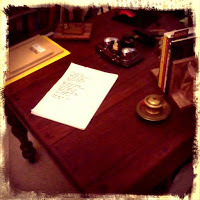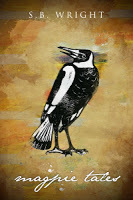Poetry Process - Element 1: Close Reading and Analysis
 The writing desk never looked
The writing desk never looked this clean againIn my post, Reinvigorating My Poetry Process or Year of Poetry 2.0, I mentioned the four elements of my process; Writing Poetry, Studying Poetic Technique and Theory, Close Reading & Analysis and Reflection.
I begin with Close Reading & Analysis because it takes the pressure of you. You can get straight on with up-skilling your craft and you don't have to worry about writing the greatest poem ever(yet).
So how do you Close Read and Analyse a Poem?
Anyway you want to...
but it helps to have some guidance until you develop your own style/preference.
I began by using The Close Reading of Poetry - A Practical Introduction and Guide to Explication, by Kim Blank & Magdelena Kay. It's from the English Department of University of Victoria.
I used Print Friendly to create a .pdf copy that I could print or carry on an offline device. (Aside: I actually prefer doing most of my writing and study in long-form i.e. hand written in journals)
The document breaks down into the following topic headings:
1. Title 2. Key Words & Tone 3. Word Order 4. Figurative Language; Imagery 5. Sound: Rhythm & Rhyme 6. Speaker & Voice 7. Time & Setting 8. Symbol 9. Form 10. Ideas & ThemeMy beginning process was to basically follow this list from point 1 to 10, writing down my observations and findings for each topic.
As the year progressed I began to "bolt on" some extra's as I went, picking up bits and pieces.
Early on I developed a rule that I should read the poem at least 3 times before sitting down to analyse it. So...
Reading
Read first for meaning, viewing the poem as a whole.Read out loud and be conscious of the way the words sound (it's also a good idea to get in practice at reading aloud, your poems or other's)Read by the line i.e. slow your reading right down.I didn't follow this process 100% of the time but certainly in the earlier stages. After awhile I think your brain just begins to do several of these things at once.
Writing
The poem you are close reading and not your own obviously.
Within the first couple of Close Readings I just found it practical to write the poem out. It would have been easier to print poems (especially those online) and stick them in, but I amassed a reasonable sized collection of poetry in book form that I didn't want to deface with my scrawl (that and it's very frustrating holding the book open for an hour while you are completing your analysis.
The added benefit to writing out the poem was that I believe it got me closer to the words, allowed me to pick up on things that didn't seem apparent after three readings. It was actually quite a pleasurable experience for me.
 Optional extras
Optional extras
I think you could easily start with the resources above Reading, Writing out the Poem and using the Guide but I wanted to mention a couple of things I added. Now again, I didn't apply these all of the time, sometimes I forgot and sometimes they weren't relevant.
Scansion and Stress/Syllable Counts (under Word Order heading)
I'd usually scan a poem and break it down into feet, even if it wasn't an obviously metered poem, just to observe patterns. I'd sometimes alternate this type of investigation with simply recording in different coloured pens, the basic syllable count and the number of hard stresses in each line, in two columns at the end of the line.
I'd also note enjambment or end stopped lines in a similar fashion, so that I could see at a quick glance how the poem varied its line endings and examine the effect that groupings of say, end stopped lines had on the sound of the poem.
Sentence Lengths/ Sentence Endings/ Line endings (under Word Order heading)
I think I may have picked up the importance of sentence lengths from reading Richard Hugo's, The Triggering Town. So in analysing a poem I found it interesting to note how long the sentence was in comparison to its fellows(what was the effect of alternating short and long sentences or stringing similar sized sentences together), whether it ended with the stanza or ran across it.
I also noted how a sentence ended. In Hugo's essay, Nuts and Bolts, he suggested that you should:
End more than half your lines and more than two thirds of your sentences on words of one syllable.It was interesting to see the effect of a short, hard stress, sans other line end attention grabbers like rhyme, at the end of a line and the effect produced by having more or less than 50 % of your lines ending in this fashion.
In Summary
Read the poem- for meaning, sound(read out loud), and by single lineWrite the poem out long hand with space for marking it upApply the topics in A Practical Introduction and Guide to ExplicationSummarise main discoveries ( to help with reflection journal later) in dot point form.
This process was fairly detailed and depending on the poem it could take 1-2 hours. I firmly believe it's time well spent and will pay you back in your own writing. A list of the poems that I applied this process to can be found here.
The next post in this series will be on developing a reading list for study in Studying Poetic Technique and Theory. Feel free to comment or ask questions. Do you follow a similar process?
 In Magpie Tales Australian poet SB Wright reveals a keen eye for capturing both people and places, his deft imagery transports the reader effortlessly from rural Australia and beyond. The pieces within explore a changing inner landscape too, where the contested terrain of small town identities and national issues are played out in clear, lyrical verse.
Magpie Tales
is his first poetry collection.
In Magpie Tales Australian poet SB Wright reveals a keen eye for capturing both people and places, his deft imagery transports the reader effortlessly from rural Australia and beyond. The pieces within explore a changing inner landscape too, where the contested terrain of small town identities and national issues are played out in clear, lyrical verse.
Magpie Tales
is his first poetry collection.Available in print: Amazon Aus, US / Book Depository / Booktopia / Bookworld / Barnes & Noble / Fishpond
Signed Copies: On request
Published on January 06, 2018 21:23
No comments have been added yet.



